1.5. Spoons & co.
Few things symbolize cooking more than a spoon, and for good reason: stirring,
tasting, adjusting the seasoning, stirring some more, and tasting again would be
virtually impossible without a good spoon! I prefer the wooden variety. In an age of
technology and modern plastics, there’s just something comforting about a wooden spoon.
Look for one that has a straight end, as opposed to a traditional spoon shape, because
the straight edge is useful for scraping the inside corners and bottom of a pan to
release fond. When it comes to cleaning them, I run mine through the dishwasher. True,
it’s bad for the wood, but I find it easier and don’t mind buying a new one every few
years.
How much of a difference does it
really make to weigh your flour? To find out, I asked friends
to measure out 1 cup of all-purpose flour and then weigh it. Ten cups later, the gram
weights were in: 124, 125, 131, 133, 135, 156, 156, 158, 162, and 163. That’s a
whopping 31% difference between the lowest and highest measurements.
How much flour is in a cup? Depends on whether you pack it in tight
(on left: 1 cup at 156 grams, then sifted) or keep it loose (on right: 1 cup at
125 grams, then sifted).
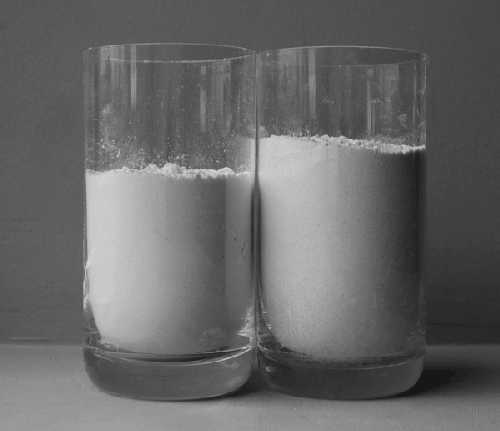
Even if you could perfectly measure the same weight with every cup, you still
might end up using a different amount than what a recipe calls for. The average weight
of the 10 samples above is 144 grams. The United States Department of Agriculture
defines 1 cup of flour as 125 grams; Wolfram|Alpha (http://www.wolframalpha.com) gives 137 grams. And the side of
the package of flour in my kitchen? 120 grams. The upshot? You’ll get better results by weighing ingredients, especially when
baking. A cup might not be a cup, but 100 grams will always be 100 grams. Clearly,
weight is the way to go. But what about wet measurements—measurements of things that don’t compress? While
you’re not going to see the same variability, you can still end up with a fair amount
of skew just based on the accuracy of the measuring device. The following image shows
what four different methods for measuring 1 cup of liquid yielded. 
212 grams Tablespoon (16 tablespoons = 1 cup)

225 grams Liquid measuring cup
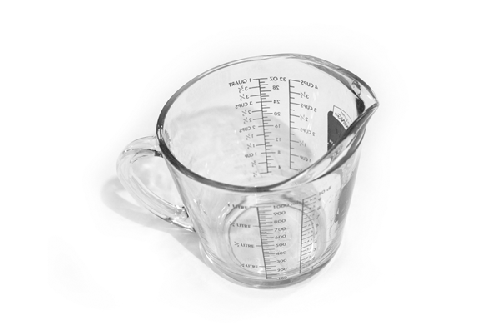
232 grams Dry measuring cup
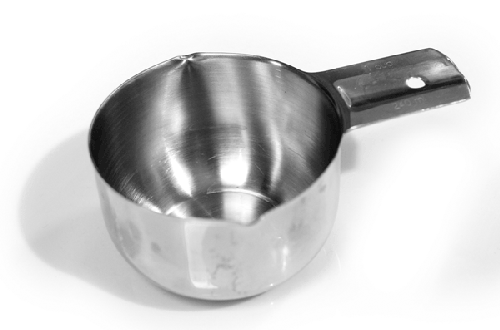
237 grams Digital scale
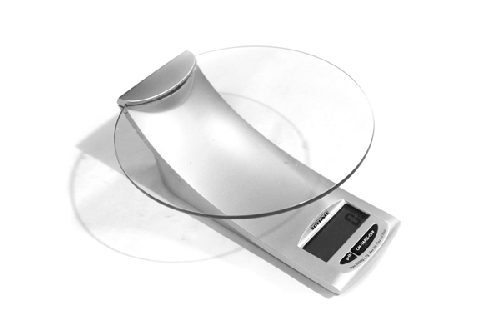
|
Besides the ubiquitous
wooden spoon, here are a few related tools that you should keep “near to hand” while
cooking.
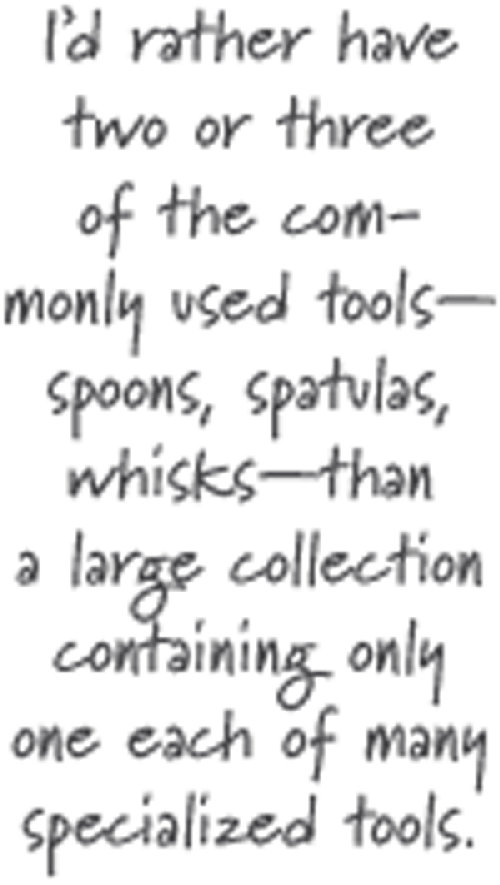
Silicone stirring spatulas. This type of spatula,
in addition to making perfect scrambled eggs, is handy for folding egg whites into
batters, scraping down the edges of bowls, and reaching into the corners of pots needing
stirring. Silicone is also heat-stable up to 500°F / 260°C.
Whisks. If you’re going to bake much, a whisk is
essential. Go for a standard balloon whisk, not one of those funky attempts at wires
with balls on the end or crazy little loopy things. Besides coming in handy when you
want to whisk eggs and dressings, you should always whisk together the
dry ingredients for baked goods to ensure that things like salt
and baking powder are thoroughly blended with the flour.
Kitchen shears. Essentially heavy-duty scissors,
kitchen shears are useful for cutting through bones and are a great alternative to a
knife for cutting leafy greens, both small (chives) and large (Swiss chard). If you’re
serving soup into bowls and want to garnish with chives, instead of using a knife and
cutting board, you can hold the chives directly above the bowl and use the shears to
snip them directly into the bowl: faster, and fewer dishes, too!
Tongs. Think of tongs as heatproof extensions of
your fingers. They’re useful not just for flipping French toast in a frying pan or
chicken on the grill, but also for picking up ramekins in the oven or grabbing a cookie
tray when you’re out of towels. Look for spring-loaded tongs that have silicone or
heatproof tips, because these can be used with nonstick coated pans. Scalloped edges are
also useful, because they tend to grip things better than their straight
counterparts.
In addition to flipping items in pans or grabbing hot ramekins from an
oven, tongs can be useful for holding on to hot foods such as just-cooked sausage
while slicing them.
